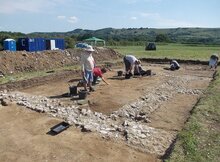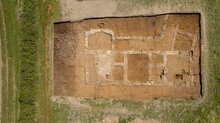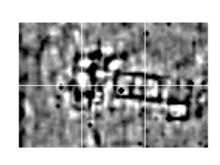Archaeological Investigations at Plumpton Roman Villa
Archaeology at Plumpton
There is an extensive archaeological record across the estate. Most of the visible ancient earthworks occur on the Downs. The first Bronze Age settlement is situated 400m south of the South Downs Way and date at 800 to 700bc in the late Bronze Age. It consists of a cluster of four enclosures, linked by sinous roads and surrounded by fields and marked by lynchets. These are ridges created by the ancient ploughing system.
The second settlement is situated a further 400m to the south-east along a wide drove-way and is marked only by a small bank and stages of crop development and Neolithic flint axes suggest that this extensive field system probably dates from the Neolithic or Early Stone Age. There are also many prehistoric burial mounds roughly in a line along the South Downs Way.
On the Weald, the most important archeological sites in the Plumpton Roman Villa in a field called Sixty Acres. Since 1977, several archaeological surveys have been carried out. They show that the villa is set in a ditched enclosure with rubbish pits and a possible kiln to the south. Tracks and a field system surround the villa whcih was probably a working farm. Since 2015, the Sussex School of Archaeology has carried out six-week field excavations of the site each summer and in 2017 unearthed a Iron Age Burial Urn from the site. The excavations will continue over the next few years involving students where possible. An exhibition of the finds is planned along with a detailed interpretation board at the site.
Roman Villa 2018
Another successful summer at Plumpton Roman Villa
This summer the Sussex School of Archaeology continued its programme of research and training excavations at Plumpton. The first task was to finish the excavation and recording of the main villa building (ie the Romano-British winged-corridor house) and then progress westwards to reveal the upper-most in-situ remains of the associated bath-house. In addition, the area to the south of the western end of the house and the baths was investigated and recorded, and some further work carried out in the area of the large flint dump to the east of the house which had been partly sampled during the summer of 2017.
Our excavations undertaken between 2014 and 2017 had established that the core of the farmhouse comprised a rectangular structure approximately 25m long and 8m wide with three rooms separated by two passages which had each been subdivided into two parts, all in an east-west orientated line. The wall foundations of these rooms consisted of an initial deposit of chalk above which were courses of mortared flints. The north-west and probably the south-west corners of this initial phase of the villa had ‘Sussex Marble’ (Paludina limestone) quoins, as may the corresponding corners to the east. The easternmost room contained traces of a chalk and flint built channelled hypocaust which was serviced by a stokehole adjacent to the exterior surface of the building’s north wall. The middle room yielded a few small mosaic cubes which may indicate the nature of part of the furnishings/flooring of this room. The third room, ie that at the western end of the house, produced little of Roman date, but did reveal cutting into the natural clay a large pit containing later prehistoric pottery.
Subsequently a corridor or veranda with stone and chalk foundations was added on the south side of the central living room and the pair of adjoining passageways. This may have replaced an earlier such structure made of timber. At its eastern end was a large wing-room with an internally apsidal wall on its south side, the external corners of which were also constructed using Paludina limestone. This room has also yielded several small mosaic tesserae. It is possible that at some stage this wing-room may have been combined with the adjacent hypocaust room in order to create a large and heated reception room. At the other end of the corridor was a less regular wing-room with walls at angles to the other walls described above. Normally one might have expected to find at this location the end of the corridor. Instead, the corridor continues to the south-west. Although its purpose is as yet unknown, this stretch of corridor may have connected the winged-corridor villa to another, perhaps timber building to the south-west.
In addition, in 2017 part of the remains of a second large masonry building, a bath house, were found just to the west of the winged-corridor house, and connected to it by a continuation westwards of the wall forming the rear of the winged-house. In 2018 we fully revealed the footprint of the former bath house and, without sampling the exposed remains and deposits, recorded the surfaces of these by photography and detailed planning. We decided to leave these remains intact as they will hopefully now be protected from further plough damage and remain as an untouched resource to be more fully explored in the future.
The north-south orientated bath suite, which was approximately 10.4 m long and 4.5 m wide internally, may have been multiphased. It comprised a probable entrance room at its south-east corner. To the west of the suggested entrance room was the cold room which had a very solid mortared floor and along its west wall a semi-circular apsidal area partly paved with thin slabs of ‘Horsham’ sandstone. These slabs and some areas with various pieces of re-used tile found lying flat may have formed the base of an apsidal plunge bath, or the support for such. This bath was emptied to the west by means of a ‘U’ shaped lead pipe contained in a tile lined drain. It appears to have emptied into a lowered area marked at the exposed level by a wide ‘halo’ of flint rubble which surrounds the north, west and southern sides of the baths. This rubble has the appearance of the infilling of a lowered area generally around the baths. To the north of the cold room was a much more disturbed area (with some box-flue and other tiles on edge etc). Judging from the geophysical soil resistivity survey results this area may be the infilled remains of two rooms – one warm, the northern most being hot. Surface finds include a complete pila tile from a hypocaust system. Along the northern wall are the remains of a tile flue-arch, and beyond this an external stokehole lined with pieces of Sussex Marble. This service area to the north of the baths proper contains traces of walls connected to the baths which may represent things such as a fuel store. Provisional dating of the tile finds suggests that the baths probably belong to the third or fourth century (ie similar to the site generally).
To the south of the baths were discovered (and sampled) two very truncated north-south and one east-west orientated ditches/gullies. Other discoveries to the east of these features included some flint-packed postholes and some pits containing much charcoal. There were also the remains of a ‘bread oven’, the infill of which included pieces of tile and some pottery.
The final area investigated in 2018 was the flint rubble spread to the east of the winged-house. This year the two trial trenches started the previous summer were finished and their sections drawn. Of particular interest are the two features (one in each trench) cut into the natural below the flint spread. One of these features appears to have been a north-south wall trench. Finds included more carbonised seeds and pottery (as found in 2017), including the complete profile of a large jar. Associated coin finds (fourth century) suggested that the provisional dating of some of the pottery found in 2017 as ‘early’ is wrong, and thus as yet nothing has been positively identified as dating to before the end of the second century.
There is still much to discover at Plumpton Villa and it is hoped that in the future attention will switch to the area south of the east-west modern track, ie the area which during fieldwalking has yielded large quantities of pottery and is likely to include the farmyard and any surrounding buildings (perhaps an aisled structure as at Barcombe). The areas investigated in 2018 will be backfilled.
David Rudling
Roman Villa 2017



In 2013/14 a programme of geophysical surveys (both resistivity and magnetometry) and limited trial trenching was undertaken by Chris Butler Archaeological Services and the Sussex School of Archaeology to more fully assess the extent, nature and condition of the Roman villa complex which was discovered in the 1970s on ploughed land to the north of Plumpton College. This work was undertaken on behalf of the College and Natural England as part of a Higher Level Stewardship agreement.
During the summers of 2015 and 2016 the Sussex School of Archaeology followed up the evaluation work of 2014 with a new programme of research and training excavations. These investigations fully revealed a winged corridor house, and confirmed that in an earlier form the house had been just a rectangular structure comprising five rooms in a line. The exposed remains of the winged house included a south-facing corridor which fronted a line of three large rooms separated by sub-divided smaller rooms, and terminated at its eastern and western ends in projecting wing-rooms. The front (southern) wall of the eastern wing-room is internally apsidal, whilst its outer face is straight. In contrast the room at the western end of the corridor, which at this point surprisingly continues to the south-west, is not square with the rest of the house.
Much of the large room to the north of the eastern wing-room contains the remains of what is thought to be an inserted rectangular ‘corn-drying’ or ‘malting’ oven. At the other end of the line of main rooms, a pit beneath the floor of the villa yielded sherds from a straight-sided Later Bronze Age pottery vessel which had four applied pierced lugs. Traces of masonry walls abutting the outer face of the western wall of the Roman-period room at this end of the villa demonstrate that further added rooms lie to the west. Evidence for the nature of some of the former flooring in the villa includes finds of both red tile tesserae and small mosaic cubes.
Just to the east of the villa is a concentration of flint rubble which may be the floor of a timber-framed building or perhaps the infill of a building with deeper foundations, such as a bath-house. Dating evidence from the villa complex in general spans the third and early fourth centuries.
The wall-footings and other remains of the villa have now been covered over to protect them from frost damage during the winter months. Further investigations, however, will resume in 2017 when another programme of research and training excavations will take place during late June-July 2017. Those interested in either registering for a training course or working as a volunteer should visit our website or email Sussex Archaeology.















